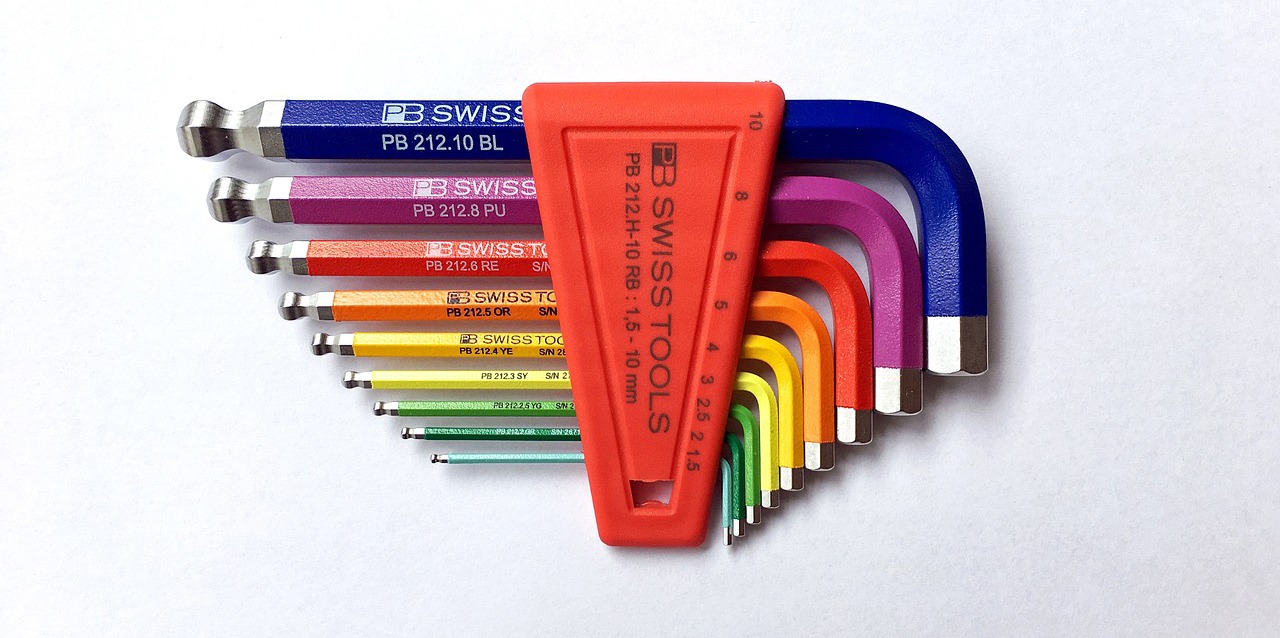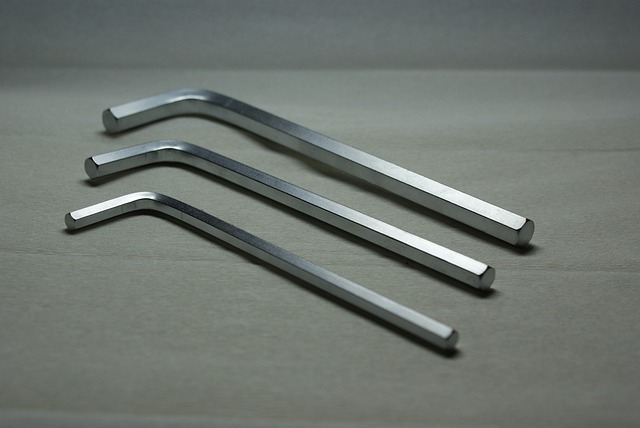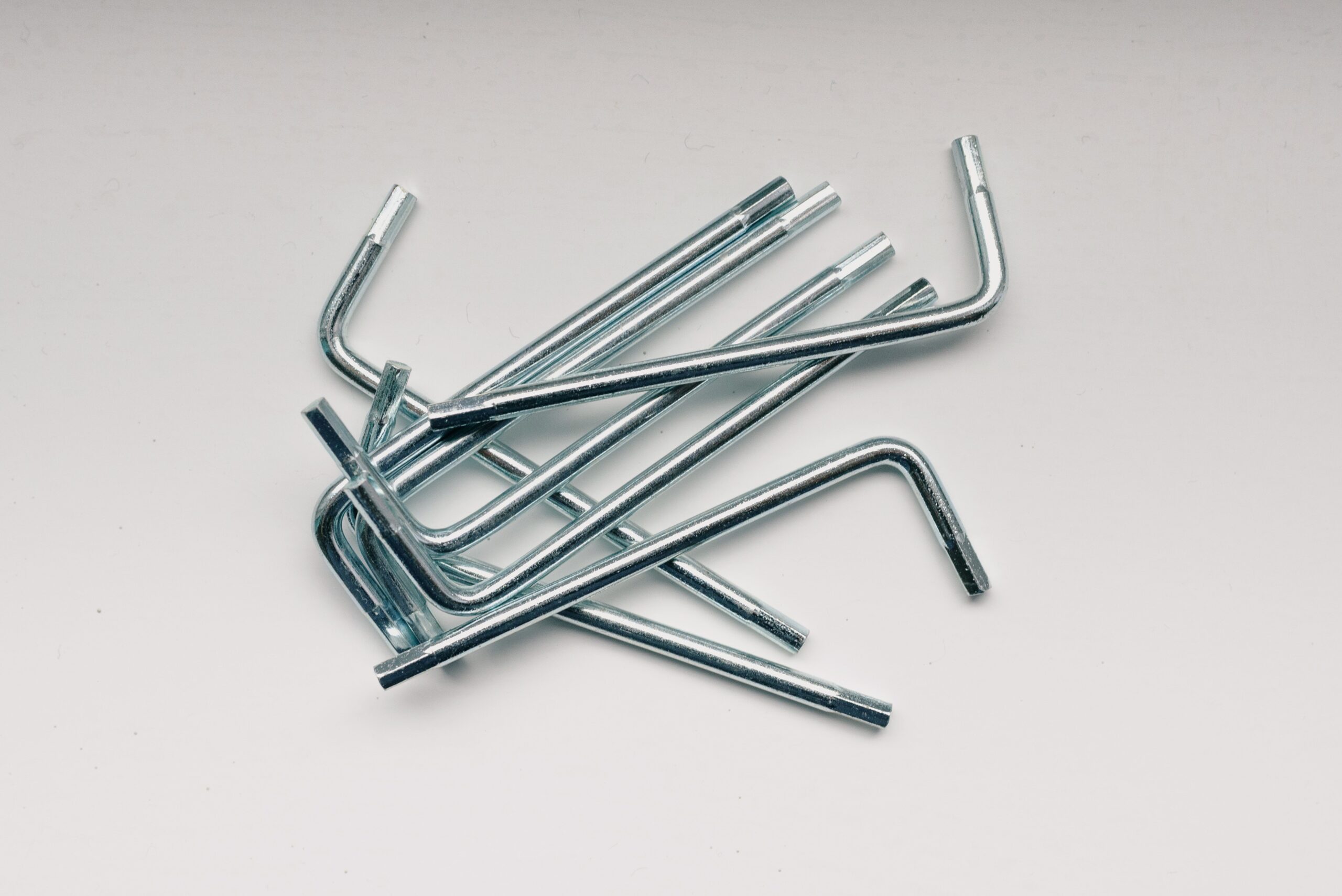Background
Hex keys, also known as Allen keys/wrenches in the United Kingdom and other countries, are a type of spanner and socket hand tool used to tighten and loosen hexagonal bolts and other compatible fasteners. Hex keys are most usually seen as a single piece of steel bent into a small L-shape, though there are a number of variations on this basic pattern available from a range of manufacturers and sources.
Hex keys and Allen wrenches are basic and versatile fastening/driving tools that are used in a wide variety of applications and product categories today. Most professional or hobbyist DIY enthusiasts – indeed, anyone with a decently well-stocked toolbox of any type – will have a few various sizes of hex keys (or perhaps full hex key sets) stowed somewhere in it.
In fact, their use has become so widespread that supplying a free hex key with flat-pack furniture, bicycles, and other products that need quick and simple assembly is now routine practice (though, unfortunately, the quality of such giveaway tools is sometimes quite questionable).
A high-quality hex wrench or Allen key set may last for many years and be used repeatedly, whereas lower-grade ‘freebie’ tools are considerably more likely to be severely limited in both adaptability to different occupations and general longevity in regular use.
History of Hex Key Sets
The hexagon key was patented for the first time in 1909 by William G. Allen (US Patent 960244), however some evidence suggests that the idea for a hex turning tool was conceived as early as the 1860s. However, due to the difficulty and expense of producing tools with anything other than the most basic shapes during the 1800s, many were not patented, or were patented but not manufactured.
William G. Allen of Hartford, Connecticut, patented a process of cold-forming a female hexagonal recess into screw heads for the Allen Manufacturing Company. The product was marketed as the “Allen safety set screw” by the business.
Many people refer to them as Allen keys, which the Apex Tool Group, which now owns the Allen Manufacturing Company, discourages. The widespread usage of the name Allen key jeopardizes their ability to maintain it as a trademark, despite the fact that “Allen wrench” was not registered as a trademark until 1943.
In his book, Howard T. Hallowell Sr, founder of the Standard Pressed Steel business, writes about how his business invented a hex key and ways of manufacturing it independently from Allen in 1911. It’s likely that this happened numerous times in different countries, as its design appears to have been patented by several companies under different names.
These include Inbus in Germany, where Bauer und Schaurte patented it, and Brugola in Italy, where Egidio Brugola owned an Italian manufacturing company.
Why was the hex key developed?
The most prevalent form of fastener used in industry around the turn of the twentieth century was a bolt with a square head. The corners of these fastening heads had a habit of catching on employees’ clothing, resulting in frequent mishaps.
This presented a chance for someone to construct a turning tool and a fastener with no edges on its head, so lowering the danger of workplace accidents.
Popularization of the Hex Key
While the hex key was increasingly used in the manufacturing industry, it was not widely used until World War II and the resulting massive increase in industrial production.
Hex fasteners have since become commonplace on a wide range of objects, including automobiles, bicycles, and furniture. Hex keys are frequently provided with self-assembly furniture these days because they are inexpensive to create.
Hex Key Features
Size and Fit
Quality hex tools fit fasteners better, resulting in a tool that can save you money and time.
A hex tool should measure as close to its quoted size as possible (e.g. 5 mm across the flats for a 5 mm size) without going over that number, or at least in an imaginary world where all fasteners are perfectly matched to specification where the socket width measures a hair over its intended size (e.g. a 5 mm socket head cap screw would have a tolerance of between 5.020 – 5.084 mm, as outlined by the American National Standards).
Leverage
The torque required is roughly proportional to the hex tool size. The stronger the holding force demanded of a fastener, the larger it should be. As a result, the tool interface should be larger to handle the increased load.
Because of this, a set of hex keys scales with increasing tool size. Similarly, the greater the leverage required to achieve (or undo) the matching torque requirement, the larger the hex key size.
Gaining leverage in a tool is frequently as simple as having a longer lever. The longer the lever, the greater force is produced for the same amount of effort. It’s a simple mechanical advantage game.
Tool Spring
As the size of a hex tool increases, so does its diameter and length. This means that hex tools for smaller fasteners are more adaptable than hex tools for bigger fasteners. This flex can be used by experienced hands to gain a good feel for the torque of a bolt.
Ball end
A standard hex tool is intended to be used in a straight line with the fastener. A ball-end allows the hex tool to be used at an angle, which substantially improves access in small spaces.
A ball-end works by curving the tool end, reducing the tool’s surface area with the fastener. As a result, ball-ends are usually inappropriate for high torque applications like initial loosening or final tightening. As a result, most hex keys will place the ball-end in a position where applying a lot of torque is difficult.
Holding Feature
A holding feature is provided to assist in securing a loose fastener to the tool. This feature is typically represented by a small sprung ball bearing, a captive O-ring, or something similar. Holding tools are often less durable than non-holding tools.
Spinners
Spinners, which are designed as a free-spinning grip that allows you to quickly whirl the tool, are commonly featured on higher-end T-handle and P-handle hex keys. A light grip on the tool accomplishes the same thing as a spinner, but it’s a feature that many people prefer.
Twisted bolt ends and other stripped bolt removal characteristics
When a fastener head is stripped, a twisted end or something similar is designed to bite into the hex socket and allow the fastener to be removed where a conventional hex key has failed. This is a newer feature found on Clever Standard’s T-handle hex keys, Park Tool’s sliding T-handle hex keys (shown above), and a few others. It’s honestly been hit-or-miss for me, and I’ve had just as much success using a tight-fitting hex key (or smashing a Torx bit into place).
While it may be useful on occasion, I would not recommend purchasing a tool solely because it has this feature.
Color classification
A variety of firms are now offering color-coded instruments for easy size identification. It’s a basic but effective life hack.
Hex Wrench Designs
There are various hex key versions on the market now, many of which roughly conform to the basic early design plan. Some manufacturers, on the other hand, embellish or embellish the basic form of a one-piece, hexagonal shaft steel tool. These may include slightly more advanced variants of the basic hex wrench, depending on the brand or provider.
L-shaped hex keys
This is the most common and popular type of hex wrench available, and it looks like a capital L. They are usually the smallest, lightest, and cheapest keys. They are available in diameters ranging from approximately 1mm to 10mm. L-shaped wrenches are extremely convenient and simple to use. They can, however, be rather uncomfortable when dealing with demanding jobs or handling them for extended periods of time.
T-handle hex keys
With a T-shaped form, the T-handle type improves on the comfort of the typical hex key. The user may now gain a considerably stronger and more comfortable hold on the instrument. T-handle wrenches are also available in a wide range of sizes and specifications, but due to their design, they are not suited for all applications. They are also more expensive than standard L-shaped keys.
P-handle torx keys
The P-handle wrench is an essential tool for all garages and workshops, combining the practicality and versatility of a typical hex wrench with the increased grip and comfort of a T-wrench. The P-handle wrench is the ideal tool for the job when you need to screw something with as much force as possible.
Multi-way hex keys
This is the generic term for a tool with many hex keys on extending arms. Not in the folding sense, but in the sense of a tool having three or more hex keys set in different directions with a plastic or metallic grip in the center.
Folding Hex keys
Folding hex and torx keys represent the ultimate in convenience and practicality. Often packing an entire set of keys into a very compact tool, folding keys are portable, practical and perfect for light-duty operations. On the downside, they can be extremely limited in terms of clearance and leverage. Therefore, folding wrench keys may not be suitable for heavy-duty or work or within a tight space.
Ratchet keys
Ratchet keys, on the other hand, are ideal for heavy-duty applications. Ratchet keys and drivers also work with most drills and powered drivers, making it even easier to drive screws, bolts, and bits into place. To know more about drills, you can take a look at The Guide to Choosing the Right Power Drill.
Screwdriver-style keys
A screwdriver-style hex key combines the familiarity of a screwdriver with an Allen key head and is excellent in terms of both usability and value for money. Sizes typically range from 1mm to 10mm in diameter, as with most other hex keys. For specialized purposes, more variations are available.
What is a hex key used for?
The short and quick answer here is that hex keys are simply a simple hand tool method for tightening and loosening specific sorts of bolts and screws, as we’ve already mentioned – and as most people are already well aware with. They’re designed for use on bolts with a recessed hex drive socket, which means a hexagonal’slot’ in the screw head (or, in the case of headless fasteners, the shaft).
Hex keys have a number of significant properties that make them especially well adapted to the simple, user-friendly fastening duty that has made them so popular among operators of all skill levels. Among these are the fact that hex keys:
- They are easily made and reasonably strong.
- They are inexpensive to produce and purchase.
- They are simple to use.
- Are lightweight and easy to hold/manipulate, especially in small areas.
- Provide six contact surfaces between the hex key and the hex head bolt to increase torque and reduce the possibility of slipping/stripping.
- Come in a variety of lengths and gauges for gradually increasing torque.
- Can be used with headless fasteners
- Are usually double-ended, providing a’spare’ hex driver in the event of damage or rounding to one end of the tool.
- Because the hexagonal profile runs the complete length of the tool in most situations, it may be easily reconditioned or renewed by simply clipping off any damaged ends using an appropriate cutting disc or grinder.
To use them, just insert one end of the driver into the recessed hexagonal fastener head and apply torque to the other end to turn it. The shorter of the hex key’s two shanks is typically used as the handle, giving the tool a longer reach and increased maneuverability in tight situations. When additional torque is necessary, the longer shank can alternatively be utilized as the ‘handle,’ provided there is adequate room in the work area to turn a longer-handled tool in.
However, while the basic applications and qualities of hex key sets do not vary greatly from brand to brand and product to product, there is some potential variation in exactly how to use a hex key properly, depending on the type and format of tool you choose to buy.
Conclusion
Hex keys are a quick and straightforward way to install and remove fasteners with hexagonal socketed heads. They do not necessitate the use of power tools or a specialized bit. They are among the most basic tools for installing and removing supported fasteners.
Hex keys guard against unintended fastener stripping. They “grip” fasteners better than other popular screwdrivers and wrenches because they are used with hexagonal fasteners. This firm grip prevents fasteners from becoming stripped during installation or removal.


